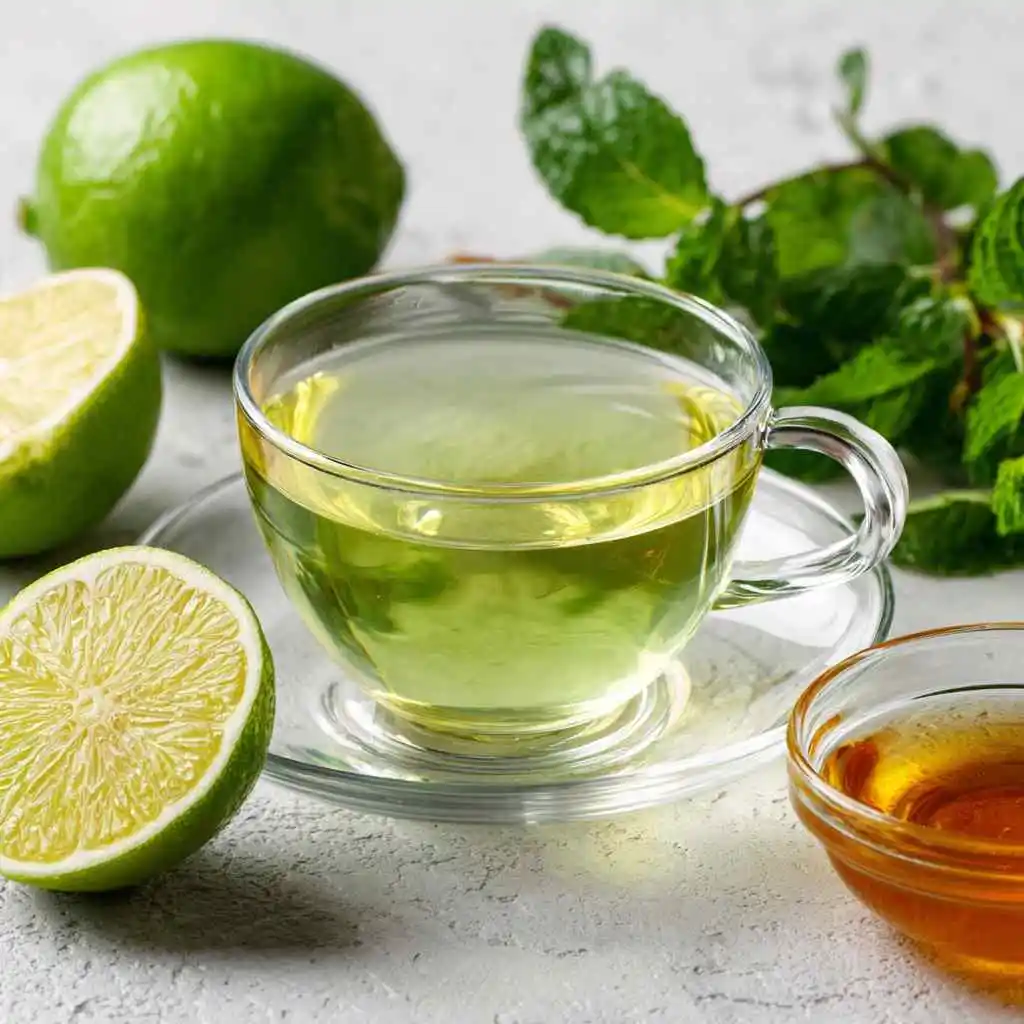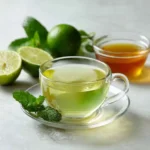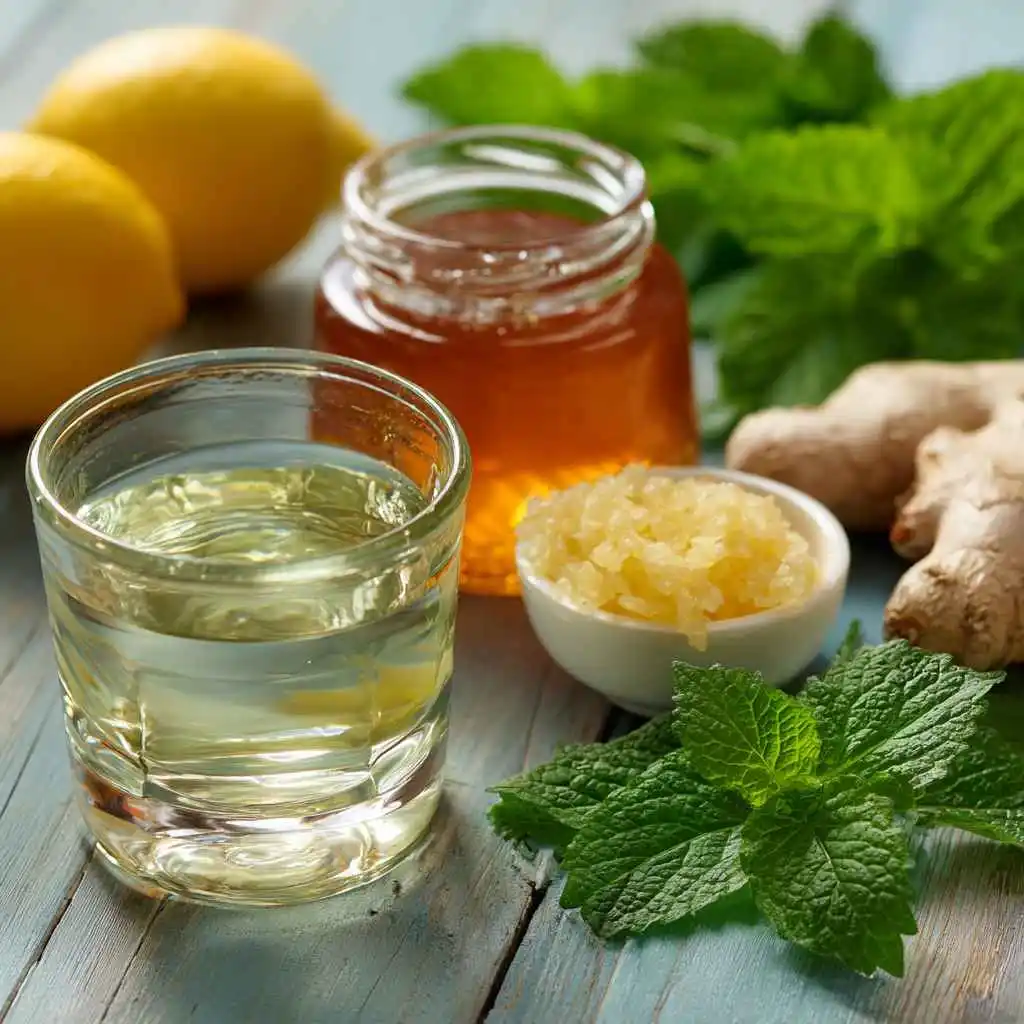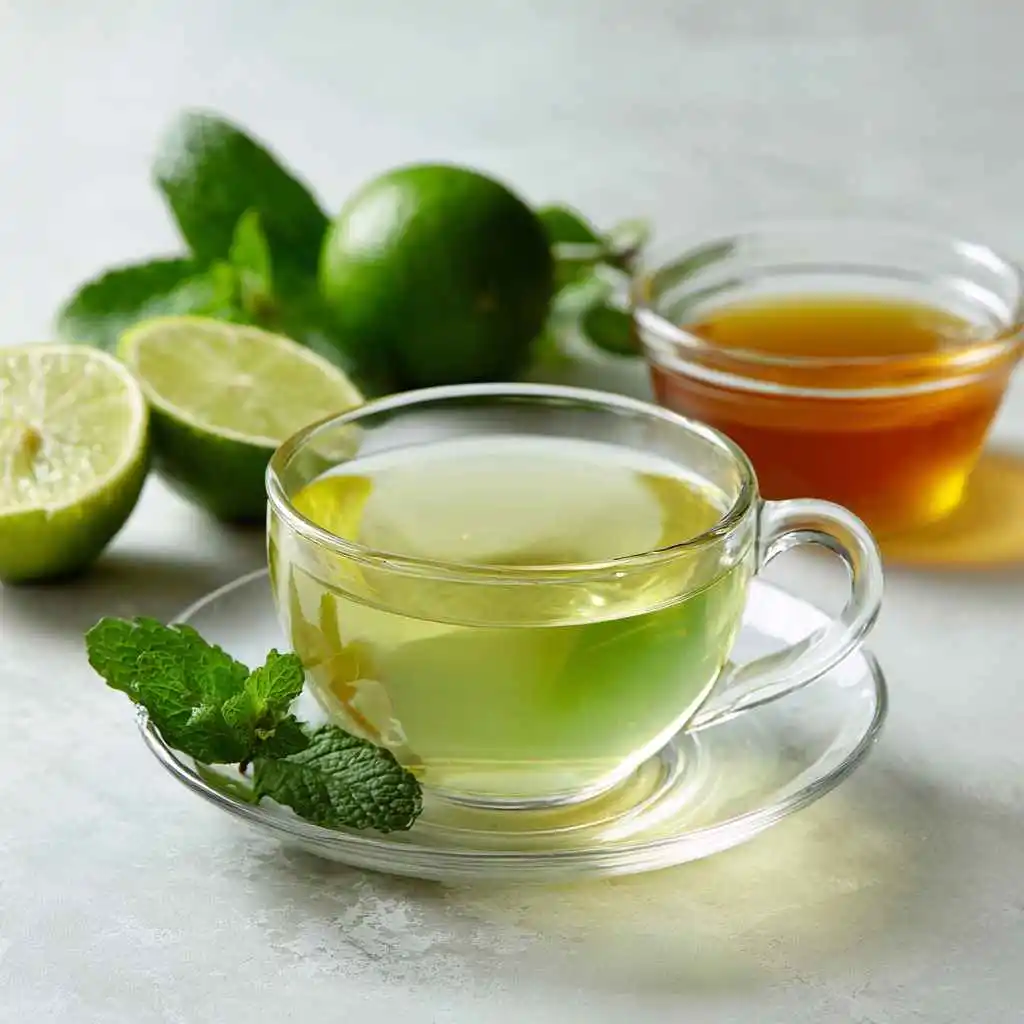
Lemon balm recipe ideas are a refreshing way to add calm and flavor to your kitchen. This soothing herbal infusion blends lemon balm leaves, fresh ginger, lemon juice, filtered water, and raw honey into a vibrant and health-boosting drink. In this article, you’ll learn exactly how to make a lemon balm recipe that’s simple, energizing, and packed with potential benefits. We’ll explore how to use lemon balm, whether it helps with belly fat, the best ways to enjoy it, and what to avoid mixing it with. This is your full guide to making lemon balm a regular part of your routine.
Table of Contents

Lemon Balm Recipe: How to Make a Soothing and Healthy Drink
- Total Time: 15 minutes
- Yield: 1 large serving (or 2 small servings) 1x
- Diet: Vegan
Description
A simple and refreshing lemon balm recipe that combines fresh lemon balm leaves, ginger, lemon juice, filtered water, and optional raw honey to create a soothing herbal tea perfect for relaxation and digestion support.
Ingredients
Ingredients:
1 cup fresh lemon balm leaves (or 1 tablespoon dried leaves)
1 teaspoon freshly grated ginger (optional)
Juice of half a lemon
2 cups filtered water
1 teaspoon raw honey (optional)
Instructions
Instructions:
Rinse the fresh lemon balm leaves and gently pat dry. If using dried leaves, measure 1 tablespoon.
Bring 2 cups of filtered water to a simmer (not a rolling boil).
Add lemon balm leaves and grated ginger to the hot water. Remove from heat, cover, and steep for 7–10 minutes.
Strain the tea into a mug. Stir in lemon juice while warm.
Add raw honey if desired, adjust to taste, and enjoy hot or chilled.
Notes
Notes:
Feel free to substitute dried lemon balm leaves if fresh ones aren’t available. You can also add a cinnamon stick during steeping for extra warmth or serve over ice with a mint sprig for a refreshing twist. Avoid using lemon balm if you take sedative medications or thyroid treatments without consulting your healthcare provider.
- Prep Time: 5 minutes
- Cook Time: 10 minutes
- Category: Beverage
- Method: Steeping
- Cuisine: Herbal / Wellness
Nutrition
- Serving Size: 1 cup (approximate)
- Calories: 30 (with honey)
- Sugar: 5g (with honey)
- Sodium: 0mg
- Fat: 0g
- Saturated Fat: 0g
- Unsaturated Fat: 0g
- Trans Fat: 0g
- Carbohydrates: 8g
- Fiber: 1g
- Protein: 0g
- Cholesterol: 0mg
Keywords: lemon balm recipe, herbal tea, calming drink, digestive support, lemon balm tea
Why I Love This Lemon Balm Recipe
A Calming Ritual That Started in My Backyard
I never expected lemon balm to become a kitchen staple. Years ago, I found it growing wild near the compost pile behind my house. Its light lemony scent reminded me of the Saturday mornings I spent baking banana bread with my mom—herbs on the windowsill, laughter in the air, and the warmth of a preheated oven filling the house. That nostalgia hit hard. So, I picked a few sprigs and brewed them into tea. That first cup was mild, citrusy, and calming. From then on, this lemon balm recipe became my go-to when I needed to slow down.
This recipe isn’t about reinventing the wheel. It’s about working with what’s already beautiful. A few leaves, a slice of ginger, a squeeze of lemon—nothing complicated. That’s what makes it special. It’s not just soothing to sip, it also helps me reconnect with quiet, steady rhythms in a busy life. This lemon balm recipe reminds me to pause, to breathe, and to enjoy flavor in its purest form.
Looking for other herb-forward drinks? I often rotate between this and my hibiscus detox blend or this cozy spiced apple tea, depending on the season.
A Lemon Balm Recipe That’s Easy and Purposeful
I keep things real in my kitchen. So this lemon balm recipe fits right in—it’s fast, flexible, and forgiving. You can use fresh or dried leaves, skip the honey, or add extra ginger. It’s herbal comfort without the rules. Plus, it feels good knowing you’re sipping something that might ease stress and support digestion naturally.
Lemon balm isn’t just another trendy herb—it’s been used for centuries to relax the body and sharpen the mind. That’s why I come back to this recipe over and over again. Simple. Effective. Homey.
And if you’re curious about creative herbal blends, don’t miss my lemon ginger turmeric infusion and detox water combos for even more inspiration.
Lemon Balm Recipe Ingredients & Preparation
Simple Ingredients with a Purpose
You don’t need much to make this lemon balm recipe—just a few fresh, calming ingredients that are likely already in your kitchen. Here’s what I use and why:
- 1 cup fresh lemon balm leaves (or 1 tablespoon dried): the star ingredient with a citrusy, mint-like aroma known for stress relief and digestive support.
- 1 teaspoon freshly grated ginger (optional): adds gentle spice and supports metabolism and gut health.
- Juice of half a lemon: brightens the flavor while providing a dose of vitamin C.
- 2 cups filtered water: the base that brings everything together.
- 1 teaspoon raw honey (optional): adds sweetness and antioxidants without overpowering the herbal notes.
This lemon balm recipe makes enough for one large mug or two small servings.

Step-by-Step: How to Make It
Step 1: Rinse your lemon balm leaves under cool water and gently pat them dry. If using dried leaves, measure out 1 tablespoon and set aside.
Step 2: In a small saucepan, bring 2 cups of filtered water to a simmer—not a rolling boil. This keeps the herbs delicate and flavorful.
Step 3: Add the lemon balm and grated ginger to the water. Turn off the heat, cover the pot, and let it steep for 7–10 minutes.
Step 4: Pour the infused tea through a strainer into a mug. While the liquid is still warm, mix in the lemon juice to enhance its fresh, citrusy brightness.
Step 5: Add raw honey if desired. Taste, adjust, and sip slowly.
This lemon balm recipe is flexible, too—feel free to chill it over ice for a cooling summer tonic. If you’re exploring more wellness drinks, my spiced citrus tea and cranberry detox water offer equally refreshing and nourishing options to pair with this lemon balm recipe.
Cooking Note & Nutritional Information
How to Make This Lemon Balm Recipe Work for You
This lemon balm recipe is wonderfully forgiving. You can tweak it depending on what you have or how you feel. If you’re short on fresh leaves, dried lemon balm works just fine. Want extra warmth? Add a cinnamon stick during the steeping process. Prefer something cold? Place the tea in the fridge to cool, then enjoy it poured over ice, topped with a fresh mint leaf.
If you’re avoiding sugar, skip the honey—or swap it for a few drops of stevia or a dash of maple syrup. Personally, I love a hint of raw honey, especially if I’m winding down at night. And on hot days, I’ll brew a larger batch, chill it, and keep it in a mason jar for quick sips throughout the day.
As always, listen to your body. Some folks find ginger too stimulating before bed, so it’s okay to leave it out. This lemon balm recipe works morning or evening, depending on what you need.
For more infusions that adapt easily to your schedule, try my chamomile mint sleep tea or this slow-steep hibiscus cooler from my cold brew herbal drinks collection.
Nutritional Breakdown & Wellness Benefits
Nutritional Breakdown (Per Serving):
- Calories: 25–35 (depends on honey)
- Sugar: 4–6g (with honey)
- Vitamin C: 15% Daily Value
- Antioxidants: High
Tips & Serving Suggestions for Your Lemon Balm Recipe

Tips to Get the Most from Your Lemon Balm Recipe
To enjoy this lemon balm recipe at its best, start with fresh leaves whenever possible. Fresh lemon balm delivers a brighter, more vibrant flavor than dried, so harvest or buy your leaves just before brewing. When using dried leaves, reduce steeping time slightly to avoid bitterness.
Don’t hesitate to customize the recipe. Adding a cinnamon stick during steeping can bring warm spice notes, or a few fresh mint leaves can add refreshing complexity. Also, experiment with honey alternatives like maple syrup or agave if you want different sweetness profiles.
Keep in mind that lemon balm can interact with certain medications like sedatives or thyroid treatments, so check with your healthcare provider if you’re unsure. Avoid mixing it with other herbs that have sedative effects unless guided by a professional.
If you want to explore more herbal blends, see my calming chamomile lavender tea or my energizing ginger turmeric tonic, both easy to make and full of flavor.
Serving Suggestions for Every Occasion
Serve your lemon balm tea hot to soothe after a long day or chilled over ice for a refreshing summer drink. Garnish with lemon slices or fresh mint for a lovely presentation. You can also infuse it into sparkling water for a fizzy twist.
Pair this lemon balm recipe with light snacks like almond biscotti, fresh fruit, or a cheese plate for a relaxed afternoon or evening ritual. It’s also excellent alongside light meals such as salads or grilled chicken, where the herbal notes brighten your palate.
For more ideas on pairing herbal drinks with meals, check out my guide to slow cooker soups and easy one-pot dinners, perfect for balanced, nourishing meals.
Conclusion
Enjoying this lemon balm recipe is a straightforward way to bring calming, fresh flavors into your daily routine. Whether served warm or cold, with a hint of honey or a squeeze of lemon, this herbal tea soothes the mind and supports digestion. Feel free to adjust the ingredients to suit your preferences and lifestyle. Using simple, natural elements like lemon balm helps create moments of wellness and relaxation. Try this lemon balm recipe and discover a gentle, refreshing beverage that fits perfectly into your day.
For more recipes follow me in Pinterest & Facebook
Frequently Asked Questions (FAQ) about Lemon Balm Recipe
What can I do with fresh lemon balm?
Fresh lemon balm is incredibly versatile. You can brew it as a soothing tea using this lemon balm recipe, add it to salads for a citrusy twist, or use it as a fragrant garnish for desserts and drinks. It also works well in pestos and marinades, lending a fresh, lemony flavor that brightens dishes.
Does lemon balm help lose belly fat?
While lemon balm offers calming and digestive benefits, there’s no direct scientific evidence that it specifically targets belly fat. However, incorporating lemon balm tea in your routine may support digestion and reduce bloating, which can contribute to a flatter feeling stomach as part of a balanced diet.
What is the best way to consume lemon balm?
A simple and common method to enjoy lemon balm is brewing fresh or dried leaves in hot water to create a soothing herbal tea, just like this lemon balm recipe. Enjoy it either hot or cold, and boost the flavor by adding some lemon juice or a bit of honey. It’s gentle, easy to prepare, and widely enjoyed.
What should not be mixed with lemon balm?
Avoid mixing lemon balm with sedative medications or herbs like valerian, as their combined effects may be too strong. Also, consult your healthcare provider before using lemon balm if you take thyroid medication or are pregnant. Always practice caution when combining herbs.
Recipes of The Same Type
